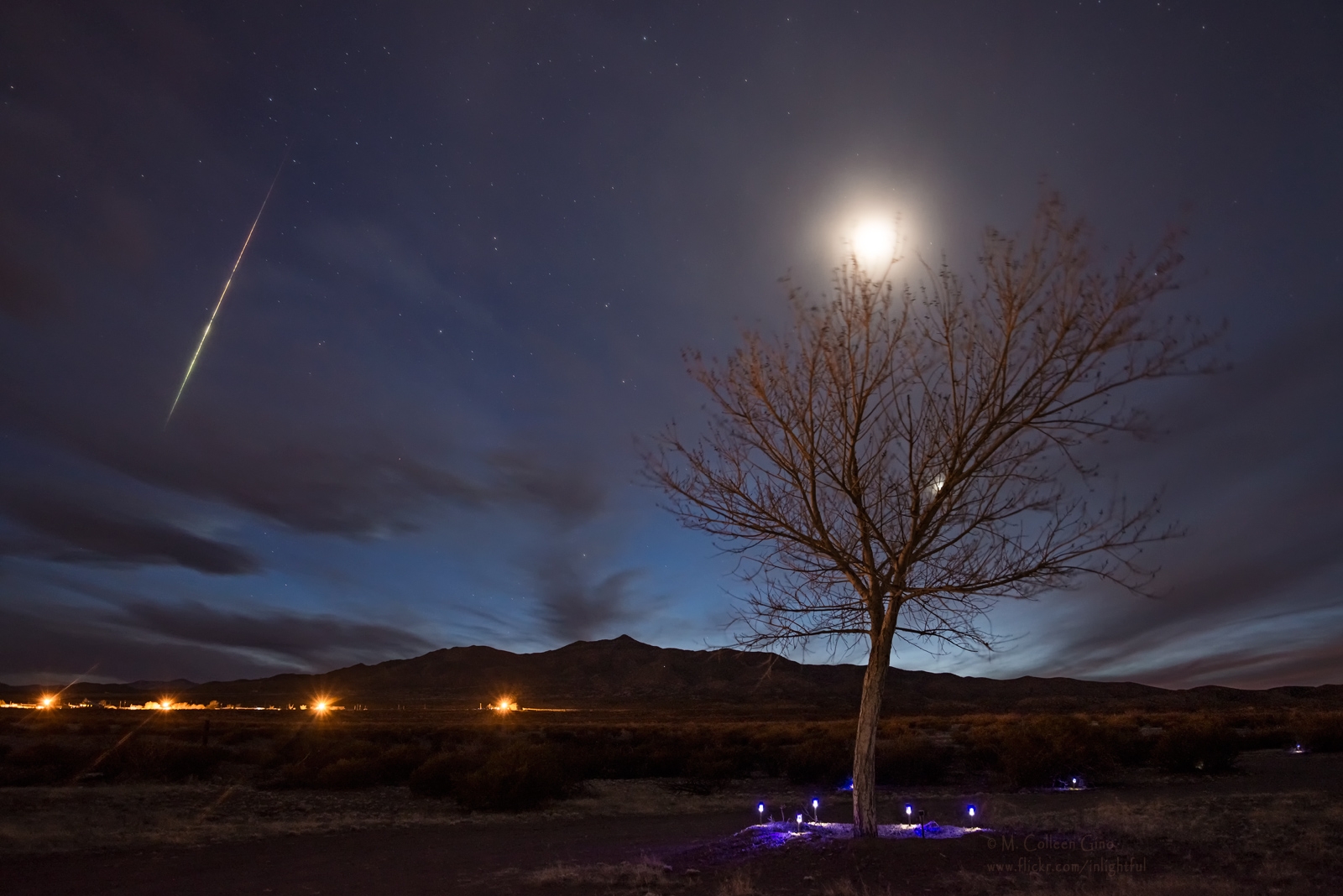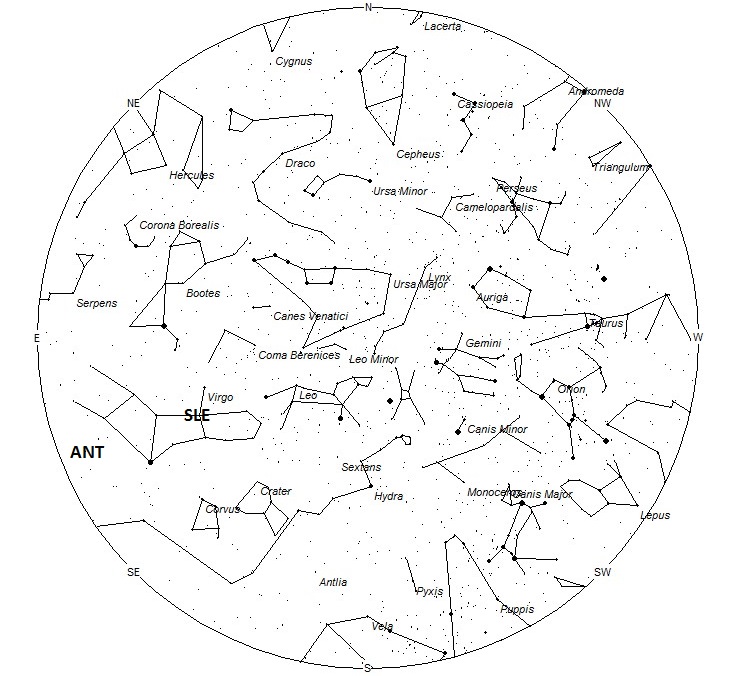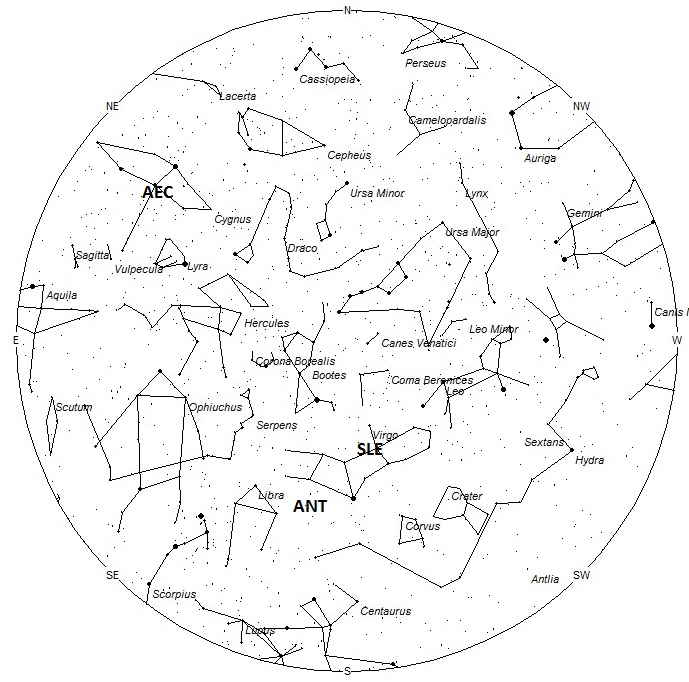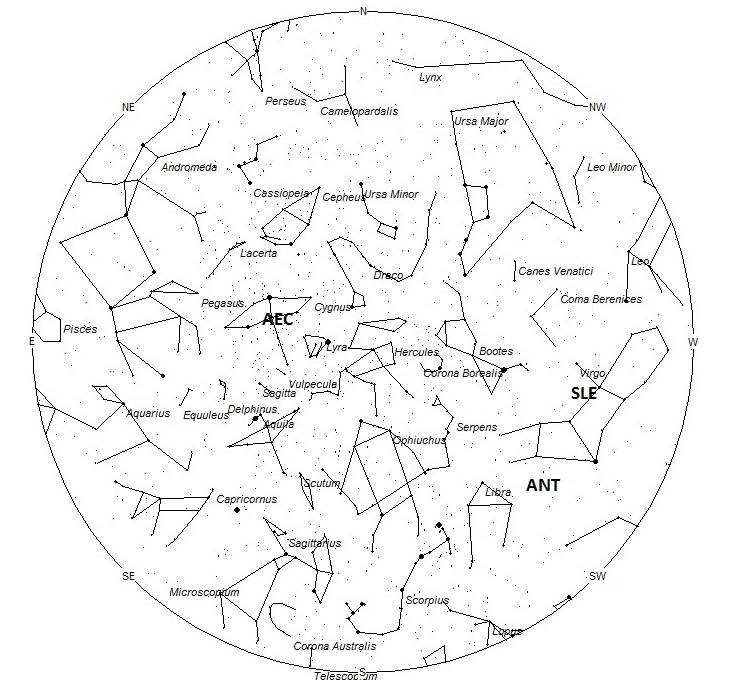
Photo shared on the American Meteor Society’s website – ©Collen Gino –2015-02-21 18:56:00 MST
“Unfortunately I didn’t witness the meteor because I had my camera set up to take a time lapse sequence of the sunset. It must have been fairly bright because I was shooting at f/4.5 ISO400 and the image was pretty underexposed at only 20 seconds, having been set for the brighter sky earlier. Shot with a Nikon D800E @24mm”
During this period the moon reaches its last quarter phase on Sunday April 12th. At this time the moon will be located 90 degrees west of the sun and will rise near 0200 local daylight time (LDT). Conditions are good up until moonrise but once the moon enters the sky this weekend fainter meteors will be lost to the moon’s glare. This situation improves with each passing night as the moon’s phase wanes and the moon rises later in the morning. The estimated total hourly meteor rates for evening observers this week is near 3 for observers situated at mid-northern latitudes and 4 for observers viewing from the southern tropics (latitude 25 S.). For morning observers the estimated total hourly rates should be near 7 for observers situated at mid-northern latitudes and 10 for observers viewing from the southern tropics. Morning rates are reduced during this period due to moonlight. The actual rates will also depend on factors such as personal light and motion perception, local weather conditions, alertness and experience in watching meteor activity. Note that the hourly rates listed below are estimates as viewed from dark sky sites away from urban light sources. Observers viewing from urban areas will see less activity as only the brightest meteors will be visible from such locations.
The radiant (the area of the sky where meteors appear to shoot from) positions and rates listed below are exact for Saturday night/Sunday morning April 11/12. These positions do not change greatly day to day so the listed coordinates may be used during this entire period. Most star atlases (available at science stores and planetariums) will provide maps with grid lines of the celestial coordinates so that you may find out exactly where these positions are located in the sky. A planisphere or computer planetarium program is also useful in showing the sky at any time of night on any date of the year. Activity from each radiant is best seen when it is positioned highest in the sky, either due north or south along the meridian, depending on your latitude. It must be remembered that meteor activity is rarely seen at the radiant position. Rather they shoot outwards from the radiant so it is best to center your field of view so that the radiant lies at the edge and not the center. Viewing there will allow you to easily trace the path of each meteor back to the radiant (if it is a shower member) or in another direction if it is a sporadic. Meteor activity is not seen from radiants that are located below the horizon. The positions below are listed in a west to east manner in order of right ascension (celestial longitude). The positions listed first are located further west therefore are accessible earlier in the night while those listed further down the list rise later in the night.
These sources of meteoric activity are expected to be active this week.
The Sigma Leonids (SLE) are active from April 8-25, with maximum activity occurring on the 16th. This shower was discovered by Cuno Hoffmeister and published in his book Meteorstrome back in 1948. Recent refinements in the radiant position indicates that the actual location of the radiant lies further east than first thought, placing it in the constellation of Virgo instead of Leo. The radiant is currently located at 13:16 (199) +03, which places it in northern Virgo, 4 degrees east of the 3rd magnitude star known as Auva (Delta Virginis). This radiant is best placed near midnight LDT, when it lies on the meridian and is located highest in the sky. Rates at this time should be less than 1 no matter your location. With an entry velocity of 19 km/sec., the average meteor from this source would be of slow velocity.
The center of the large Anthelion (ANT) radiant is currently located at 14:20 (215) -14. This position lies in southeastern Virgo, near the spot occupied by the faint star known as Lambda Virginis. Due to the large size of this radiant, Anthelion activity may also appear from eastern Hydra, northern Centaurus, and Libra as well as eastern Virgo. This radiant is best placed near 0100 LDT, when it lies on the meridian and is located highest in the sky. Rates at this time should be near 2 per hour as seen from the northern hemisphere and 3 per hour as seen from south of the equator. With an entry velocity of 30 km/sec., the average Anthelion meteor would be of slow velocity.
The April Rho Cygnids (AEC) are active from April 8-25, with maximum activity occurring on the 16th. This shower was discovered by Dr. Peter Brown and associates using data from the Canadian Meteor Orbit Radar. The radiant is currently located at 20:20 (305) +41, which places it in central Cygnus, just northwest of the 2nd magnitude star known as Sadr (Gamma Cygni). This radiant is best placed during the last dark hour before dawn when it lies highest above the horizon in a dark sky. Rates at this time should be near 1 per hour as seen from the northern hemisphere and less than 1 as seen from south of the equator. With an entry velocity of 42 km/sec., the average meteor from this source would be of medium velocity.
As seen from the mid-northern hemisphere (45N) one would expect to see approximately 4 sporadic meteors per hour during the last hour before dawn as seen from rural observing sites. Evening rates would be near 2 per hour. As seen from the tropical southern latitudes (25S), morning rates would be near 7 per hour as seen from rural observing sites and 3 per hour during the evening hours. Locations between these two extremes would see activity between the listed figures.Morning rates are reduced due to moonlight.
The list below offers the information from above in tabular form. Rates and positions are exact for Saturday night/Sunday morning except where noted in the shower descriptions.
| SHOWER | DATE OF MAXIMUM ACTIVITY | CELESTIAL POSITION | ENTRY VELOCITY | CULMINATION | HOURLY RATE | CLASS |
| RA (RA in Deg.) DEC | Km/Sec | Local Daylight Saving Time | North-South | |||
| Sigma Leonids (SLE) | Apr 16 | 13:16 (199) +03 | 19 | 00:00 | <1 – <1 | IV |
| Anthelions (ANT) | – | 14:20 (215) -14 | 30 | 01:00 | 2 – 3 | II |
| April Rho Cygnids (AEC) | Apr 16 | 20:20 (305) +41 | 42 | 07:00 | 1 – <1 | IV |
 American Meteor Society
American Meteor Society



Hi
Last evening at about 11:45pm my wife and I looked out our front window which overlooks Lake Superior and saw what we think was a fireball in the sky to the north of us. We live in Northern Ontario on the north shore of Lake Superior about 30 minutes north of Sault Ste. Marie, ON on Hwy 17. It was very bright and looked like it was burning. We could see what looked like flames protruding from the ball. We watched for about 5 minutes as it slowly disappeared. Unfortunately we were so intrigued that we didn’t think to grab the camera. It was quite amazing to witness!
Nick Huizing
Sorry but fireballs due not last 5 minutes. They enter the atmosphere at such high velocities that they only last a matter of seconds before disintegrating. Your object sounds more like a sky lantern, which is a miniature hot air balloon.
Robert Lunsford
American Meteor Society
Hi, I was discouraged to know that if you register viewing a fireball that one cannot post one lasting than 30 seconds. The one I saw this am. was a bright blazing orange fireball with a long train. It lasted for over 4 minutes covering a large section of sky. First time I look out for one but I have read quite a lot on them thes last few weeks. If it wasn’t a reportable sighting then what was it? Thanks. WT
Sorry but fireballs due not last 4 minutes. They enter the atmosphere at such high velocities that they only last a matter of seconds before disintegrating. The resulting train can last that long but not the meteor itself.
Robert Lunsford
American Meteor Society
Is it possible that I saw a meteor in San Diego between 5pm and 6pm, while it was still daylight? I’ve never seen one during the day but it was so amazing 🙂